No…not the big yellow guy of Sesame Street fame. These are the birds that soar overhead, perch in nests the size of small houses, or wade quietly in estuaries and ponds.
There’s really no perfect way to go about this since, ultimately, there are so many birds that are part of Outer Banks’ life that writing about all of them is simply not possible.
To make this manageable, we’ve divided the Big Birds into Raptors and Herons. It’s somewhat arbitrary but seems to be a handy way to write about them.
Raptors
Eagles
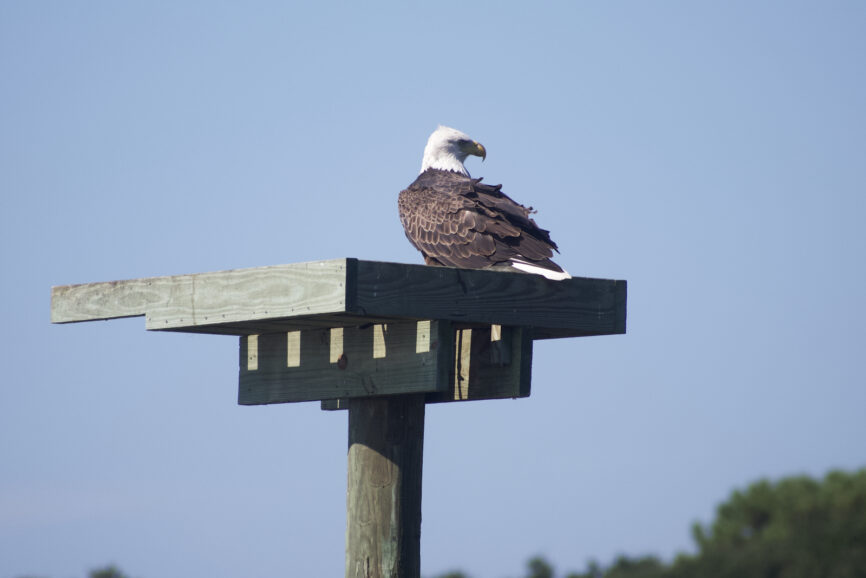
There is no mistaking a mature bald eagle. The white head, brown body, and size leave no doubt in identifying the bird. It is one of the largest raptors on the North American continent. The California Condor is way bigger, and the Golden Eagle tends to be slightly larger, but since the Condor is exclusively a West Coast bird and Golden Eagles mostly West Coast, the large brown bird with slightly blocky wings soaring high overhead is almost certainly an Eagle.
Eagles have been making quite a comeback on the Outer Banks. As recently as ten years ago, they were uncommon in the area. They are a long way from numerous, but it is no longer surprising to see one.
They are an interesting bird. For all their size and strength, eagles would just as soon steal another bird’s catch as hunt for their own. That characteristic, in fact, was the reason Benjamin Franklin objected to bald eagles as our nation’s symbol, writing, “He is a Bird of bad moral Character. He does not get his Living honestly. …”
Eagles are somewhat migratory, so they are a bit more numerous in warmer weather, but a few seem to stay around all year. The best way to see one is just to keep your eyes open.
Osprey
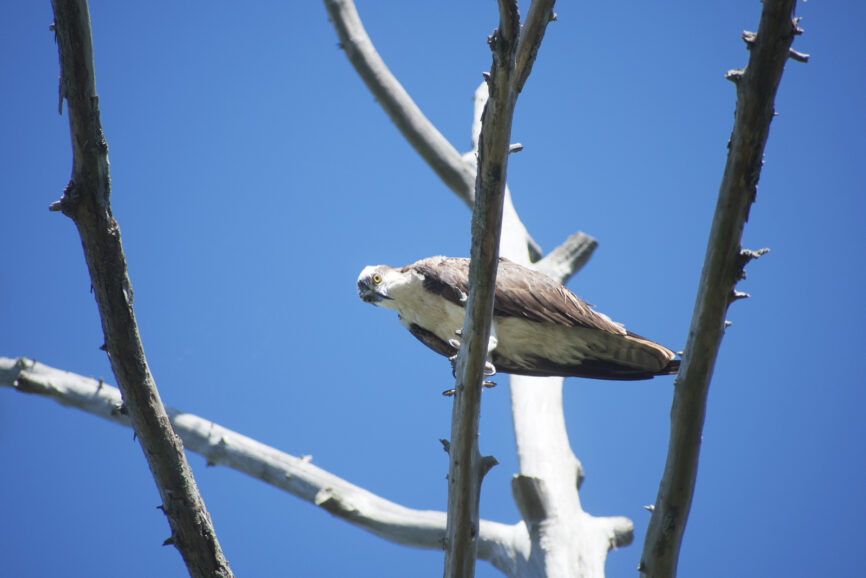
Very graceful in flight with markedly thinner wings than eagles, Osprey are remarkably successful at fishing—according to the Cornell Lab of Ornithology, they grab a fish “…at least 1 in every 4 dives, with success rates sometimes as high as 70 percent.”
The local osprey population seems to be migratory and we don’t see any in the winter. However, by late March, they are always back. Nesting pairs return to the same nest, adding on to the existing structure so their nests get huge.
Their nests are in large trees or on platforms high above water with abundant fish. For the past few years there has been an osprey nest at Sandy Run Park in Kitty Hawk. Ospreys also frequent Jockey’s Ridge State Park along the Roanoke Sound shoreline.
A beautiful bird that has adapted very well to human presence.
Turkey Vulture
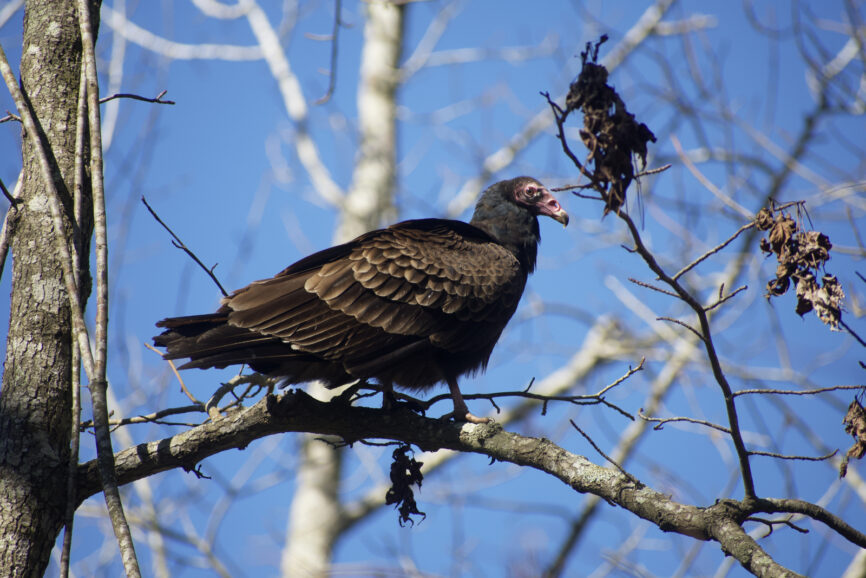
By far the most common raptor on the Outer Banks, or North America for that matter, in flight Turkey Vultures are a wonderful sight as they soar effortlessly in the sky. Of course, by human standards, many of their habits on the ground are pretty disgusting, but they play an invaluable role in all ecosystems. In places where vultures have been eliminated, sickness invariably follows as carrion becomes disease laden.
In flight, Turkey Vultures have a slight resemblance to eagles, but there are marked differences. The wings are held in a distinctive V shape, unlike the eagle, whose wings are extended flat and straight. Eagles also tend to fly much higher than turkey vultures, consistent with how the birds hunt. Turkey Vultures hunt by scent, so they need to be closer to the ground; eagles use their, well, eagle eye to hunt.
The easiest way to spot a turkey vulture is to look up. However, two interesting places to see them in flight are at Run Hill State Natural Area where they soar the uplift from the dune and at Sandy Run Park in Kitty Hawk. From time to time, a kettle or group of birds will gather on the cell phone tower on the north end of the park.
It’s a good idea not to get too close to this species. Their main defense mechanism is projectile vomiting—considering their diet, it’s an effective tool.
Herons
Great Blue Heron
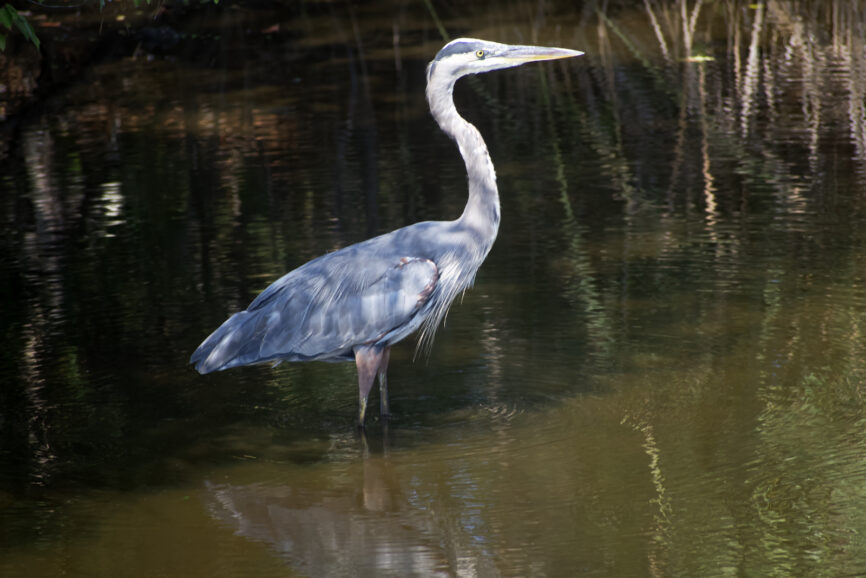
Great Blue Heron are the wading bird most likely to be seen. The color is really more of a blue-gray, but whether blue or blue-gray, this is a beautiful bird.
And it’s big—the largest North American heron.
They are often seen in the water standing still or moving very slowly as they stalk their quarry, usually frogs, fish, snakes, and an occasional small mammal. When they strike, it is with a lightning-fast jab of their sharp beak into the water to either impale or sometimes grab their prey in their very strong mandibles.
They are a very graceful bird in flight, with a wingspan of six to seven feet.
Look for them in still fresh water to slightly brackish waters. They do not seem to like salt water all that much. Two great places to get a glimpse of them are Roanoke Marshes Conservation Area on the road to Wanchese, or Sandy Run Park in Kitty Hawk.
Tricolored Heron
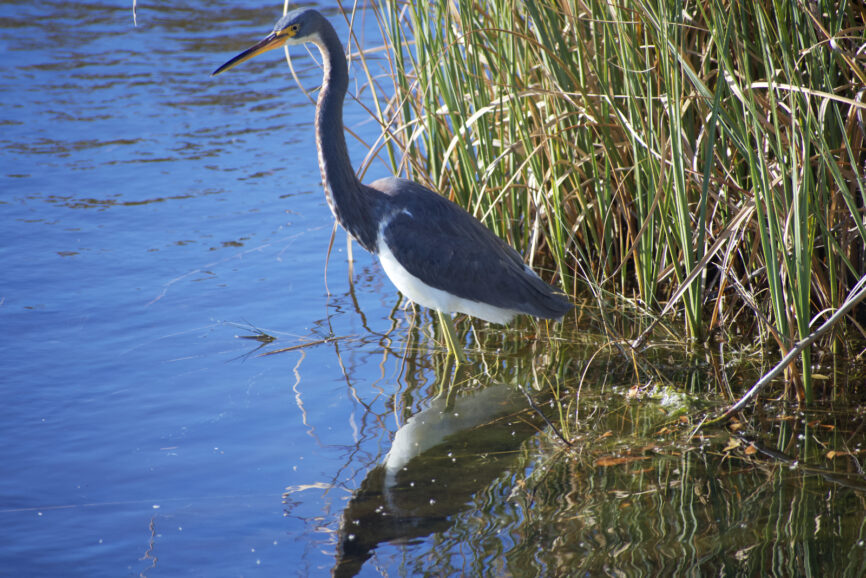
Smaller than its cousin, the great blue heron, and certainly more colorful, the Tricolored Heron is not as common as the blue heron, but they are around.
Their hunting technique is similar to the great blue heron, although they are more active when stalking prey—usually small fish. They will seem to take a series of quick steps through the water before going for a meal.
At first glance they look a little like a blue heron, but the striking white belly and yellow legs set them apart.
There seems to be some nesting activity of them at Roanoke Marshes Natural Area, so that’s a good place to look. They are also seen from time to time in the salt marsh at the wooden overlook at the end of the Bodie Island Lighthouse boardwalk.
Great Egret
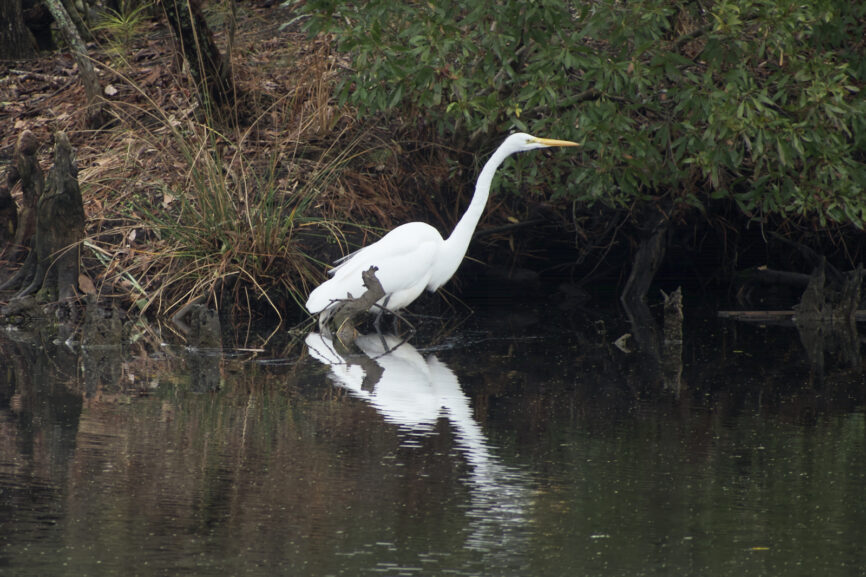
With their crisp white feathers and slim body, Great Egrets are beautiful birds. To a significant degree, they share a habitat with great blue herons, so any place a blue heron is hanging out, there’s a good chance a Great Egret is nearby.
However, unlike blue herons, the Great Egret will nest by and hunt in brackish to even salt water, although it is not an ocean or beach bird. The species does require shallow, still water to forage for food.
They hunt in classic heron style, stalking their prey slowly and patiently, then striking with a remarkably quick thrust of their beak to impale the fish, frog, or whatever they’re stalking.
There are usually a few of them around Sandy Run Park in Kitty Hawk. However, they nest in the thousands at Pea Island National Wildlife Refuge.
Birds Not Included
Of course there are some important birds not included simply because of space. There are a number of hawks that are seen on the Outer Banks. The Red-tailed Hawk is the most commonly seen hawk in the area. A migratory species, it is most usually seen soaring overhead in the summer.
There are three other members of the heron family that are common in the area. The green heron is a smaller, quite athletic bird that will often perch in trees. The snowy Egret is somewhat similar to the great egret, but smaller with a black instead of a white bill, and seen almost exclusively at Pea Island National Wildlife Refuge. Cattle egrets are the birds that perch on the backs of the Corolla Wild Horses.
